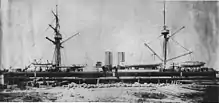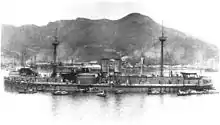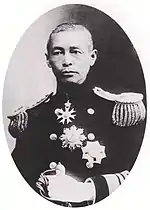Imperial Chinese Navy
The Imperial Chinese Navy was the modern navy of the Qing Empire established in 1875. An Imperial naval force in China first came into existence from 1132[1] during the Song Dynasty and existed in some form until the end of the Qing period in 1912. However, the "Imperial Chinese Navy" usually only refers to the Qing navy which existed between 1875 and 1912.
| Imperial Chinese Navy | |
|---|---|
| Active | 1875–1912 |
| Country | |
| Allegiance | |
| Branch | Navy |
| Garrison/HQ | Shanghai |
| Fleets | Beiyang Fleet Fujian Fleet Guangdong Fleet Nanyang Fleet |
| Insignia | |
| Ensign of the Imperial Chinese Navy | .svg.png.webp) |
History
Precursors
The Second Opium War showed the complete futility of the pre-modern Chinese fleet when facing modern European navies, when 300 Chinese naval junks, armed with British-made guns, did almost no damage to 56 British and French ironclads. In the 1860s, an attempt to establish a modern navy via the British-built Osborn or "Vampire" Fleet to combat the Taiping rebels' US-built gunboats. The so-called "Vampire Fleet" fitted out by the Chinese government for the suppression of piracy on the coast of China, owing to the non-fulfilment of the condition that British commander Sherard Osborn should receive orders from the imperial government only, was scrapped.[2]
Establishment of the Qing navy
In 1865, the Jiangnan Shipyard was established.
In 1874, a Japanese incursion into Taiwan exposed the vulnerability of China at sea. A proposal was made to establish three modern coastal fleets: the Northern Sea or Beiyang Fleet, to defend the Yellow Sea, the Southern Sea or Nanyang Fleet, to defend the East China Sea, and the Canton Sea or Yueyang Fleet, to defend the Taiwan Strait and the South China Sea. The Beiyang Fleet, with a remit to defend the section of coastline closest to the capital Beijing, was prioritised.
A series of warships were ordered from Britain and Germany in the late 1870s, and naval bases were built at Port Arthur and Weihaiwei. The first British-built ships were delivered in 1881, and the Beiyang Fleet was formally established in 1888. In 1894 the Beiyang Fleet was on paper the strongest navy in Asia at the time. However, it was largely lost during the First Sino-Japanese War in the Battle of the Yalu River. Although the Zhenyuan and Dingyuan modern battleships were impervious to Japanese fire, they were unable to sink a single ship and all eight cruisers were lost.[3] The battle displayed once again that the modernisation efforts of China were far inferior to the Meiji Restoration. The Nanyang Fleet was also established in 1875, and grew with mostly domestically built warships and a small number of acquisitions from Britain and Germany.
The admiralty or naval board (haijun yamen) was established in 1885.
The Nanyang Fleet fought in the Sino-French War, performing somewhat poorly against the French in all engagements.
The separate Fujian and Guangdong fleets became part of the Imperial navy after 1875. The Fujian Fleet was almost annihilated during the Sino-French War, and was only able to acquire two new ships thereafter. By 1891, due to budget cuts, the Fujian Fleet was barely a viable fleet. The Guangdong Fleet was established in the late 1860s and based at Whampoa, in Canton (now Guangzhou).
After the First Sino-Japanese War, Zhang Zhidong established a river-based fleet in Hubei.
In 1909, the remnants of the Beiyang, Nanyang, Guangdong and Fujian Fleets, together with the Hubei fleet, were merged, and re-organised as the Sea Fleet and the River Fleet.
In 1911, Sa Zhenbing became the Minister of Navy of the Great Qing.
One of the new ships delivered after the war with Japan, the cruiser Hai Chi, in 1911 became the first vessel flying the Yellow Dragon Flag to arrive in American waters, visiting New York City as part of a tour.[4][5][6][7]
Successors
After the Xinhai Revolution in 1911 and the establishment of the Republic of China in 1912, the Imperial Chinese Navy was replaced by the Republic of China Navy. The People's Liberation Army Navy was established in early 1949 by the Communist Party of China, and after the establishment of the People's Republic of China later that year became the main navy of China.
Fleets
- Beiyang Fleet - North Sea Fleet based from Weihaiwei
- Nanyang Fleet - South Sea Fleet based from Shanghai
- Guangdong Fleet - based from Canton (now Guangzhou)
- Fujian Fleet - based from Fuzhou, founded in 1678 as the Fujian Marine Fleet [8]
Bases
- Beiyang Fleet: Liugong Island, Weihaiwei (1888-1895); occupied by Japan 1895-1898, leased to Britain 1898-1940 (until 1930 as part of Weihaiwei); re-occupied by Japan 1940-1945; used by Communist forces from 1945
- Nanyang Fleet: Shanghai, Nanjing
- Fujian Fleet: Foochow Arsenal, near Fuzhou (1866—1884) - fleet base of the Qing navy and naval yard and School of Naval Administration in the late 19th century; ancient shipbuilding centre
- Guangdong Fleet: Whampoa, Canton
Governance
In 1885, after the Sino-French War, the Qing court set up a Navy Office to oversee the navy. In 1910, as part of the reform of the Qing government structure, the Navy Office was replaced by a Navy Ministry, headed by a Navy Secretary.[9]
The highest ranks of the navy after the merger of the fleets in 1909 were:
- Admiral of the Imperial Chinese Navy (Zheng Dutong)
- Vice Admiral of the Imperial Chinese Navy (Fu Dutong)
- Rear Admiral of the Imperial Chinese Navy (Xie Dutong)
- Commodore of the Imperial Chinese Navy (Tongdai)
- Fleet leader of the Imperial Chinese Navy (Duizhang)
When it was first developed by Empress Dowager Cixi, the Beiyang Fleet was said to be the strongest navy in East Asia. Before her adopted son, Emperor Guangxu, took over the throne in 1889, Cixi wrote out explicit orders that the navy should continue to develop and expand gradually.[10] On the eve of the First Sino-Japanese War, the German General Staff predicted a victory for China and William Lang, who was a British advisor to the Chinese military, praised Chinese training, ships, guns, and fortifications, stating that "in the end, there is no doubt that Japan must be utterly crushed".[11] However, after Cixi went into retirement, all naval and military development came to a drastic halt. The military defeats suffered by China has been attributed to the factionalism of regional military governors. For instance, the Beiyang Fleet refused to participate in the Sino-French War in 1884,[12] the Nanyang Fleet retaliating by refusing to deploy during the Sino-Japanese War of 1895.[13] Li Hongzhang wanted to personally maintain control of this fleet, many top vessels among its number, by keeping it in northern China and not let it slip into the control of southern factions.[14] China did not have a single admiralty in charge of all the Chinese navies before 1885;[15] the northern and southern Chinese navies did not cooperate, therefore enemy navies needed only to fight a segment of China's navy.[16]
Ship types
Pre-19th-century ships were wood and of various sizes.
- fu po (warship) - 19th-century ships
- hai hu or sea hawks
- combat junks
- louchuan (樓船) - tower ships of the Ming dynasty
- mengchong or covered swoopers (艨艟): leather-covered assault warship - ships of the Three Kingdoms period
- river boats - Song Dynasty
- wugongchuan, or centipede ship - 16th century galley based on Portuguese types
- yu ting or patrol boats
- zhan xian or combat junks
- zou ge or flying barques
Following the First Opium War, the Qing improved their naval fleet with modern ships from Europe:
Battleships:
Coastal Defense Ships:
- Pingyuan (1890)
Cruisers:
- Chaoyung class
- Jiyuan (1883)
- Kai Che class
- Kai Che (1882)
- King Ch'ing (1886)
- Huan T'ai (1886)
- Nan Thin class
- Nan Thin (1883)
- Nan Shuin (1884)
- Fu Ch'ing (1893)
- Chih Yuan class
- Chih Yuen (1886)
- Ching Yuen (1886)
- King Yuan class
- Lung Wei (1888)
- Tung Chi class
- Tung Chi (1895)
- Fu An (1894)
- Hǎi Qí class
- Hai Yung class
- Hai Yung (1897)
- Hai Chou (1897)
- Hai Shen (1898)
- Chao Ho class
Corvettes:
Flags
Flags shown are for the Imperial Chinese Navy during the period 1909 to 1911:[17]
.svg.png.webp) Naval Ensign of the Imperial Chinese Navy
Naval Ensign of the Imperial Chinese Navy.svg.png.webp) Flag for the Imperial Chinese Navy Secretary
Flag for the Imperial Chinese Navy Secretary.svg.png.webp) Command flag for Imperial Chinese Navy Admiral
Command flag for Imperial Chinese Navy Admiral.svg.png.webp) Command flag for Imperial Chinese Navy Vice Admiral
Command flag for Imperial Chinese Navy Vice Admiral.svg.png.webp) Command flag for Imperial Chinese Navy Rear Admiral
Command flag for Imperial Chinese Navy Rear Admiral.svg.png.webp) Command flag for Imperial Chinese Navy Commodore
Command flag for Imperial Chinese Navy Commodore.svg.png.webp) Command flag for Imperial Chinese Navy Senior Officer's/Fleet Leader
Command flag for Imperial Chinese Navy Senior Officer's/Fleet Leader.svg.png.webp) Imperial Chinese Navy Duty Ship Pennant
Imperial Chinese Navy Duty Ship Pennant.svg.png.webp) Imperial Chinese Navy Commission Pennant
Imperial Chinese Navy Commission Pennant
Notes:The Commodore was not a substantive rank, but rather a captain commanding a squadron.
References
Citations
- Needham, Joseph (1986). Science and Civilization in China: Volume 4, Physics and Physical Technology, Part 3, Civil Engineering and Nautics. Taipei. Caves Books Ltd. p. 476.
- Clowes, Sir William Laird (1903). "SHERARD OSBORN'S CHINESE FLEET". The Royal Navy: A History from the Earliest Times to the Death of Queen Victoria. vol. 7. London: Sampson Low, Marston and Company. pp. 171–172.
- Mark Peattie, David C. Evans (1997). Kaigun: Strategy, Tactics, and Technology in the Imperial Japanese Navy. United States: Naval Institute Press. p. 44. ISBN 9780870211928.
- "Flag, Pearl & Peace". Time magazine. July 17, 1933. Retrieved 2010-12-18.
The cruiser Hai Chi ("Flag of the Sea") earned in 1911 the distinction of being the first Chinese war boat ever to visit the West when she steamed as near as possible to the Coronation of King George V, discharged a cargo of Chinese emissaries in gorgeous silken robes. Built in 1897 the Hai Chi and the equally venerable Hai Shen ("Pearl of the Sea") were still listed last week as the only cruisers in China's Northeastern Squadron.
- "Chinese Cruiser Welcomed To Port. First Ship Flying the Yellow Dragon Flag to Anchor in American Waters". New York Times. September 11, 1911. Retrieved 2010-12-18.
Who cruiser Hai-Chi of the Imperial Navy of China, the first vessel of any kind flying the yellow dragon flag of China that has ever been in American waters, steamed into the Hudson yesterday morning and anchored in midstream opposite the Soldiers and Sailors' Monument, at Eighty-ninth Street.
- "Men Of Chinese Cruiser Hai-Chi Are Entertained". Christian Science Monitor. September 12, 1911. Retrieved 2010-12-18.
Officers and men of the Chinese cruiser Hai-Chi, which arrived at this port Monday, are to be given ample opportunity to see New York during their stay of 10 days here. ...
- New York Tribune September 12,1911
- Li, Guotong (Sep 8, 2016). Migrating Fujianese: Ethnic, Family, and Gender Identities in an Early Modern Maritime World. BRILL. p. 71. ISBN 9789004327214.
- Li, Miles. "Imperial Chinese Navy Flags (1909)". crwflags.com. CRW Flags, 24 May 2007. Retrieved 12 March 2017.
- Chang, Jung (2013). The Concubine Who Launched Modern China: Empress Dowager Cixi. New York: Anchor Books. pp. 182–84. ISBN 978-0307456700.
- Liu, Kwang-Ching (1978). John King Fairbank (ed.). The Cambridge History of China. Volume 11, Late Ch'ing, 1800–1911 Part 2 (illustrated ed.). Cambridge University Press. p. 269. ISBN 0-521-22029-7.
- Loir, M., L'escadre de l'amiral Courbet (Paris, 1886), 26–29, 37–65.
- Lung Chang [龍章], Yueh-nan yu Chung-fa chan-cheng [越南與中法戰爭, Vietnam and the Sino-French War] (Taipei, 1993), 327–28.
- Bruce A. Elleman (2001). Modern Chinese warfare, 1795–1989 (illustrated ed.). Psychology Press. p. 87. ISBN 0-415-21474-2. Retrieved 2012-01-18.
Not surprisingly, considering Li Hongzhang's political power, many of the best and most modern ships found their way into Li's northern fleet, which never saw any action in the Sino-French conflict. In fact, fear that he might lost control over his fleet led Li to refuse to even consider sending his ships southward to aid the Fuzhou fleet against the French. Although Li later claimed that moving his fleet southward would have left northern China undefended, his decision has been criticized as a sign of China's factionalized government as well as its provincial north-south mindest.
- 姜文奎 (1987). 《中國歷代政制考》. 臺北市: 國立編譯館. pp. 839、840.
- Bruce A. Elleman (2001). Modern Chinese warfare, 1795–1989 (illustrated ed.). Psychology Press. p. 87. ISBN 0-415-21474-2. Retrieved 2012-01-18.
there was little, if any, coordination between the fleets in north and south China. The lack of a centralized admiralty commanding the entire navy meant that at any one time France opposed only a fraction of China's total fleet. This virtually assured French naval dominance in the upcoming conflict.
- Li, Miles. "Imperial Chinese Navy Flags (1909)". crwflags.com. CRW Flags, 24 May 2007. Retrieved 12 March 2017.
Sources
- Cole, Bernard D. The Great Wall at Sea: China's Navy in the Twenty-First Century (2nd ed., 2010)
- Graff, David Andrew and Robin Higham (2002). A Military History of China. Boulder: Westview Press.
- Miles Li, (2007) "Fujian Arsenal" temporary exhibition at the Hong Kong Museum of Coastal Defence.
- Needham, Joseph (1986). Science and Civilization in China: Volume 4, Physics and Physical Technology, Part 3, Civil Engineering and Nautics. Taipei: Caves Books Ltd.



